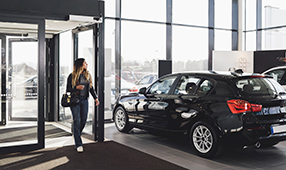Budget-minded households across the U.S. are looking for ways to save money on new purchases—especially big-ticket items. If you’re one of the millions of Americans planning to buy a new car or truck soon, here are a few tips to help keep dollars in your pocket.
While a good price is always key, the safety record and total cost to insure the make and model you select should be serious considerations.
Doing a little research before you head to the dealership can save you money—both on the sticker price and on your monthly car insurance costs.
What are the safest cars to buy now?
Over the years, more cars on the road, coupled with distracted or aggressive motorists, has resulted in an increase in the number and severity of crashes. Auto manufacturers have made great strides in improving driver and passenger survivability in a collision, but not all vehicles have the same technology and materials.
So how do you know if you’re buying the safest car, truck, SUV or minivan possible? If you want a vehicle that has been put through the paces and sports top-of-the-line safety features that can help protect you and your family in the event of an accident, be sure to consult the Insurance Institute for Highway Safety’s (IIHS) annual Top Safety Picks list. It’s one of the best guides to find automobiles that excel at protecting passengers.
The IIHS measures performance in a series of crash tests, including those for side and front impact, roof strength, and head restraint for driver and passengers. The tests also look at headlight performance and the availability of front crash prevention systems. After each test, the vehicle is rated as Poor, Marginal, Acceptable or Good (the highest rating).
To earn an IIHS Top Safety Pick award, a vehicle must earn ratings of Good or above in a number of tests and criteria. Vehicles that earn a Top Safety Pick+ rating comprise the best of the best performers.
More than 100 cars and trucks made the IIHS 2021 Top Safety Pick list, and 64 clinched the Top Safety Pick+ award. Of the latter group, Volvo led all automakers, with 15 2021 Top Safety Pick+ winners. Mazda and Audi tied for second with seven each, and Subaru took third place with five.
Choosing a make and model that performs well in crashes can not only increase your peace of mind but also help decrease your monthly car insurance bill.
How does buying a safe car lower my car insurance?
Whether you pay in cash or take out a loan to finance your new vehicle, you don’t want a surprise when you sign up for car insurance. Factor in that cost before you even take a test drive by doing some research online to find safe vehicles, taking steps to reduce your monthly premiums, and checking with your insurance company to see what it might cost to insure the vehicle you have your eye on.
Many factors determine your insurance premiums, such as your age, driving record and where you live. Insurance companies also look at the make and model’s loss history—the number and severity of claims—to help set rates.
One quick way to research that information is to look at the rankings published by NerdWallet. They reviewed last year’s 25 best-selling models and analyzed rates to determine which ones will help you save the most money on your auto insurance premiums. Of those, the 10 cheapest vehicles to insure (average annual insurance premium and retail prices, respectively, are in parentheses) are:
1. Subaru Outback ($1,392; $26,645)
2. Jeep Wrangler ($1,416; $28,295)
3. Honda CR-V ($1,439; $25,050)
4. Subaru Forester ($1,465; $24,495)
5. Ford Escape ($1,476; $24,885)
6. Ford F-150 ($1,505; $28,745)
7. Chevrolet Equinox ($1,511; $23,800)
8. Jeep Cherokee ($1,521; $26,085)
9. Toyota Tacoma ($1,527; $25,050)
10. Toyota RAV4 ($1,555; $25,950)
A lot of mid-sized vehicles and SUVs are on NerdWallet’s top-25 list, with luxury and sporty cars costing more. In general, the data shows that expensive models had higher repair bills after a collision, and smaller cars sustained more damage and had higher injury claims.
Keep in mind that, while not on this list, electric vehicles cost more to insure, as do cars most targeted by thieves.
Auto insurance can include collision and comprehensive coverage. Collision pays for the damage to your vehicle if you hit a tree, wall, fence, guardrail or another vehicle. Comprehensive pays for damage to your vehicle from anything other than a collision, such as theft, hail, wind, fire, animals and floods.
Both comprehensive and collision coverage come with a deductible. All states mandate that you have liability protection, but comprehensive and collision are optional. If you finance your vehicle, your lender usually will require that you have both coverages. If you paid cash and opt out of comprehensive and collision coverage, you’ll have to pay out of pocket if your vehicle is stolen, damaged or if you have an accident.
Your NEA member benefits can help you save
As an NEA member, you have access to benefits to help you buy and insure your new vehicle:
The NEA Auto Buying Program lets you see what other car buyers have paid, plus get member pricing through Certified Dealers.
The NEA Auto & Home Insurance Program offers coverage options and packages to help you get the insurance you need.












